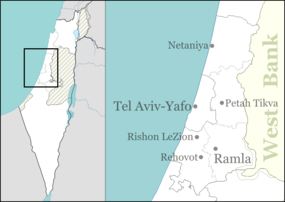Arsuf
| Απολλωνία Σώζουσα أرْسُوف |
|

An aerial view of the Tel.
|
|
| Alternate name | Arsur |
|---|---|
| Location |
|
| Coordinates | 32°11′42.72″N 34°48′24.48″E / 32.1952000°N 34.8068000°ECoordinates: 32°11′42.72″N 34°48′24.48″E / 32.1952000°N 34.8068000°E |
| Grid position | 132/178 PAL |
| Type | Lowland castle |
| History | |
| Abandoned | 1265 |
| Site notes | |
| Condition | Ruin |
| Website | Apollonia National Park - Israel Nature and Parks Authority |
Apollonia (Greek Απολλωνία) was an ancient city in Hellenistic and Roman Judea, in the late Roman era renamed to Sozusa (Σώζουσα, or Sozusa in Palestina for disambiguation with Sozusa in Libya). It was situated on a cliff above the Mediterranean Sea, about 34 kilometres (21 mi) south of Caesarea.
It fell to the Muslim conquest in 640 and was fortified against Byzantine attacks, now known as Arsuf (Arabic: أرْسُوف ʾArsūf, Latinized Arsur). It was re-conquered by the kingdom of Jerusalem in 1101, and was a strategically important fortress in the Third Crusade, during which the Battle of Arsuf (1191) was fought nearby. The fortress fell to the Mamluks in 1265 and was destroyed.
The site of Arsuf (Tel Arshaf; תֵּל אַרְשָׁף, also Apollonia–Arsuf אַפּוֹלוֹנְיָה-אַרְסוּף) is now in Herzliya municipality, Israel (just north of Tel Aviv). The site was intensively excavated from 1994. In 2002, the site was named Apollonia National Park.
The city is first recorded under its Greek name Apollonia in the final decades of the Persian period (mid 4th century BC). In a long-standing suggestion, first proposed by Charles Simon Clermont-Ganneau in 1876, it was assumed that the Greek name was given due to the interpretatio graeca of the Canaanite deity Resheph (ršp) with Apollo (as god of the plague), suggesting that the settlement would originally have been a "Phoenician" (Canaanite) foundation. The Semitic name ršp would then have been "restored" in the medieval Arabic toponym of Arsūf. While there is no archaeological evidence for a settlement prior to the Persian period, Izre’el (1999) upholds this identification, suggesting that the Semitic name might have been preserved by the Aramaic-speaking Samaritan community. The Saramitan chronicle of Abu l-Fath (14th century, written in Arabic) record a toponym rʿšfyn (with ayin). Izre’el (1999) considers the possibility of identifying this toponym with the Arabic Arsūf, assuming that the ayin may derive from a mater lectionis used in Saramitan Aramaic orthography. A tradition connecting the name with the biblical Resheph, a grandson of Ephraim, is spurious.
...
Wikipedia

